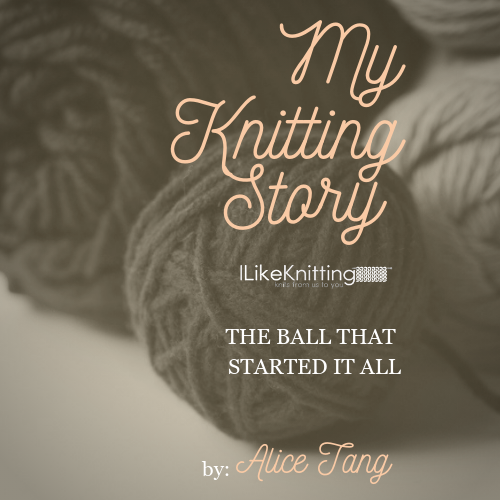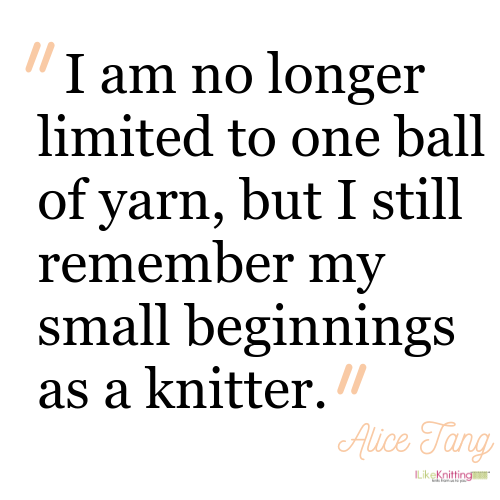
I was fascinated by knitting at a young age. When I was 3 years old, my grandmother took me to a machine knitter and she measured me for a sweater. I still remember the white/yellow/green striped fabric on the knitting machine before it became my sweater. My mother was an expert knitter but she was

I was fascinated by knitting at a young age. When I was 3 years old, my grandmother took me to a machine knitter and she measured me for a sweater. I still remember the white/yellow/green striped fabric on the knitting machine before it became my sweater. My mother was an expert knitter but she was away with my father. My father was a chef and worked for an American diplomat in Jamaica. My grandmother was taking care of my sister and me. After much begging, my grandmother agreed to teach me to knit when I was 5 years old.
My grandmother took out a small ball of rose colored yarn and a pair of double pointed knitting needles which were whittled from bamboo sticks by my mother. She showed me how to do the long tail cast on and knit; literally, she didn’t know how to purl. I learned to knit English style but since I was left handed, I did mirror knitting. I figured out how to purl by myself but my purl stitches were twisted because by inserting the left needle into the front leg twists the stitch. I didn’t realize my purls had a twist until my mother commented that it was a nice touch to twist my ribbing.
I started knitting clothes for my Barbie doll and also learned to crochet from our neighbor who had a job crocheting trims on sweaters. Since I only had enough yarn for one Barbie outfit, I had to unravel each outfit to make a new one. After 5 or 6 outfits, my yarn was full of knots so I stopped cutting the yarn. I still remember a strand of yarn that connected a tank top and pants because I couldn’t bear the cut them apart and create yet another knot.

To this day I refuse to steek or do cut and sew. Cutting yarn unnecessarily seems so wrong. Minimizing cutting also minimizes yarn ends which reduces the number of ends to weave in. Using longer lengths of yarn is one way of minimizing yarn ends. I buy cone yarns when available because they are usually a pound or more which means entire sweater pieces can be knitted without joints. Brown sheep and Jaggerspun yarn comes in cones and these are my go-to cones.
I like to plan ahead when it comes to knitting. I tie enough yarn to sew the seam into a bow BEFORE measuring yarn for the long tail cast-on for say a sweater front or sleeve. When binding off, I think about seams, crochet edgings or whatever needed before cutting the yarn.
Since I was forced to use my right hand after entering school, I can now knit ambidextrously. I knit with my right hand from right to left and with my left hand left to right. It saves a lot of time – especially for entrelac knitting. There’s no need to turn the work, there’s less purling required (I work on the side with less purls) and my hands get rested every other row – all factors that increase my knitting speed. I learned to knit English style and still do that most of the time. But when ribbing, I find that it’s easier to switch between knit and purl continental style right-handed.
I also switch between hands when knitting in the round. I like the idea of no seams but I prefer knitting sweaters flat because of accurate sizing. No matter how big my swatch is my gauge always varies some. For instance when knitting the sweater back, by the time you get to the armholes, it can be measured accurately. If it’s 4 stitches too small, bind off 2 less stitches at the first armhole cast off at each side and then continue per the pattern. When making the front, cast on 4 more stitches for the front then the back and bind off 2 extra stitches at each armhole. This moves the side seam slightly backwards (or forwards if the back was bigger than the front) and won’t be noticeable and the size would be closer to desired.
The cabinets in my laundry room hold only a portion of my stash and the rest are stored in clear plastic bins in the guest room. I like clear bins so I can see what’s inside. My cone yarns are on yarn trees that are decorative as well as functional. But even with a couple hundred pounds of yarn, often when I have an idea for a design, I still don’t have the right fiber, thickness or color that I want and, like so many knitters, always need to buy more yarn.
I am no longer limited to one ball of yarn, but I still remember my small beginnings as a knitter. As I look at my now rather large stash, I’m grateful for those who taught me along the way so that I could become the knitter I am today.
What’s your knitting story? I’d love to hear about your “small beginnings” that led to your knitting passion.
Tangram Knits features knitwear designs by Alice Tang. Her designs have been published in leading knitting magazines Interweave Knits, Simple Knitting, Cast On, Knit’N Style and others. She also designed for Red Heart, Classic Elite, Knitpicks, and Premier yarn companies. Alice studied fashion design at Fullerton College.




Alice, I would be so grateful if you could help me with the Elegant Cabled Shrug. I’m on second part..the Front side, l only see 3 rows out of the 4 in the cable patterns used in the 24 rows, therefore, I will have no cable! I really want to get back to it, so any help you could give me be great, the sooner the better. I am 82, you know, just sayin’
Hello Judie! I’ve reached out to the designer for advice and she or I will reply as soon as possible. Thanks! – Nicola, Editor